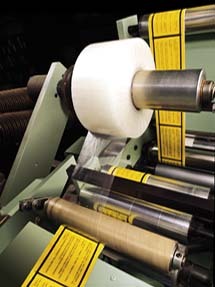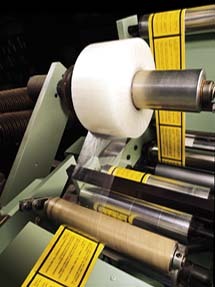Vehicles + Vinyl
Finding the Clear Choice, Part 1
What overlaminates are right for your job?
Published
18 years agoon

Years ago, the limited range of vinyl overlaminating films simplified product selection. Used on everything from tanker markings to safety labels, a few polyester laminates were all that was available. Today, the range of products includes a variety of facestocks, adhesive systems and release liners.
Common facestocks include polyester, polypropylene, polyvinyl fluoride (PVF), polycarbonates, and cast and calendered vinyl. Although glossy overlaminates sharpen color contrast, matte finishes soften colors and contrast, thus hiding printing imperfections. When used for indoor applications, matte finishes also minimize the glare of fluorescent store lighting.
Two types of overlaminate adhesive systems exist: heat-activated and pressure-sensitive. Though heat-activated films are cheaper and protect paper prints, pressure-sensitive laminates are the only the choice to use with vinyl.
Pressure-sensitive overlaminates protect photographs and digital prints, as well as P-O-P and tradeshow graphics. Compared with heat-activated overlaminating films, pressure-sensitive films provide greater durability, optical clarity, ease of use, and diverse finishes and textures. Although cold laminates cost more initally, this is offset by less frequent print damage, lower scrap cost and less reworking.
Because the heat of thermal overlaminates can damage thermal-transfer, piezo and phase-change inkjet prints, pressure-sensitive overlaminating films are the only option. Heat-activated overlaminates can also damage or distort some plastic print media. Even some types of paper media will warp at elevated temperatures.
Heat-activated adhesives still offer lower cost and better adhesion to paper prints. The bond of a cold, glue adhesive to a print isn’t so stable. Pressure-sensitive adhesives are coated onto the facestock as a liquid, and, after the coating process, the adhesive is dried in a curing oven.
AdvertisementStill, the adhesive maintains a degree of fluidity. A fluid adhesive can cause the overlaminate to slip or shift on print media, especially if the two materials expand and contract at different rates. When this shifting occurs, a "tunnel" can develop after the print is rolled. $image1
Key considerations
Options facilitate selecting the right product for a specific application, but too many choices can complicate a purchasing decision. Picking the best overlaminate requires matching product performance characteristics to the application’s demands.
The overlaminate, print media and printing method must be collectively selected as part of a total system solution. Also, duly consider the project’s environment. Durability depends heavily not only on environment, but also upon the printing process and raw-material interactions with each other. As always, the customer’s expectation is very important.
A process of elimination streamlines options. Here are some important considerations:
* What is the application? It’s important to pick the right tool for the job. Whether the task involves floor graphics, perforated window graphics or fleet markings will dictate the appropriate overlaminate.
Advertisement* What substrate will receive the graphics? Will it be smooth, such as flooring, an acrylic or polycarbonate sign face, or will the graphics be positioned over rivets or corrugations?
* What environment will the graphic endure? Will there be temperature extremes, UV light, water or pollution? Will it be subject to acidic or alkaline cleaning agents, or could it be exposed to vandalism, grease or road salts?
* Under what lighting conditions will the graphic be viewed?
* What are the job’s durability requirements?
* Is the overlaminating film compatible with other components of the graphics system?
Printed fleet graphics
AdvertisementMost fleet graphics don’t need overlaminate protection. However, exceptions include inkjet or electrostatic graphics. Even screenprinted vinyl and graphics printed via thermal transfer can require overlaminates in special cases.
Overlaminates protect printed vinyl from scratching, UV degradation, abrasion, moisture, dirt, grafitti and chemicals. Be cautious of ex-tended-durability claims, such as assertions that a laminate will double the print’s outdoor life.
Durability really depends on the ink system and its exposure to UV light. Consider the installation site’s latitude, altitude and amount of time exposed to direct light. Exposure to severe UV light can bleach out most colors. The right overlaminate can provide a certain amount of added protection, but don’t expect miracles. All fluorescent colors — and even certain non-fluorescent colors, such as magenta — will always be vulnerable.
Some, but not all, overlaminates provide UV protection by either absorbing or reflecting UV light. With one type of overlaminate, substances in either the facestock or adhesive absorb UV light. The absorbers convert UV radiation to heat, which prevents print damage. The film’s UV blockage is cumulative; eventually, the substances reach a saturation point at which the film can’t absorb any more light. The other type of overlaminate merely reflects UV rays.
When choosing an overlaminate for screenprinting applications, test the components before using them in production. Because they need a thicker layer of ink, screenprinted graphics typically require an overlaminate with a heavier coating weight of adhesive. An overlaminate with a thin adhesive coating will bridge the edge, causing a slight, but noticeable, air pocket.
The substrate and durability requirements impact the appropriate selection of vinyl film and overlaminate for fleet graphics. Two key considerations are the type of substrate and durability requirements. The rule of thumb dictates using a calendered-vinyl overlaminate with a calendered vinyl film and a cast-vinyl overlaminate with a cast vinyl film.
Similar films typically expand and contract at the same rate. If not, the overlaminate can delaminate from the base film or substrate. A tunnel could also form between the two films. In my opinion, the cast-vinyl option is usually the safest bet for fleet applications, especially for graphics applied over rivets and corrugations.
To make installations easier, use a cast film with a repositionable adhesive. More forgiving adhesive systems help prevent "pre-adhesion" of the graphic to the substrate. In turn, the installer needs to reposition the graphic much less frequently. This is important because excessive handling can cause delamination.
Overlaminates can ease vinyl application, because the added thickness not only makes the graphic more rigid and easier to handle, but also simplifies the graphics’ removal. Some experienced decal installers can even apply these stiffer prints without application tape.
Large, one-piece digital graphics, however, should be covered with premium-grade, low-tack application tape after lamination. The application tape protects a graphic against scratches during installation and prevents graphic distortion. This is especially important when applying graphics in hot weather, when vinyl can stretch like a piece of warm taffy.

SPONSORED VIDEO
Introducing the Sign Industry Podcast
The Sign Industry Podcast is a platform for every sign person out there — from the old-timers who bent neon and hand-lettered boats to those venturing into new technologies — we want to get their stories out for everyone to hear. Come join us and listen to stories, learn tricks or techniques, and get insights of what’s to come. We are the world’s second oldest profession. The folks who started the world’s oldest profession needed a sign.
You may like

American Sign Museum Names New Executive Director

3 Things Print Pros Must Do to Build Stronger Relationships in the Interiors Market

Graphics Turn an Eyesore Cooler Into a Showpiece Promo in Historic Plaza
Subscribe

Bulletins
Get the most important news and business ideas from Signs of the Times magazine's news bulletin.
Most Popular
-

 Tip Sheet1 week ago
Tip Sheet1 week agoAlways Brand Yourself and Wear Fewer Hats — Two of April’s Sign Tips
-

 Ask Signs of the Times3 days ago
Ask Signs of the Times3 days agoWhy Are Signs from Canva so Overloaded and Similar?
-

 Real Deal1 week ago
Real Deal1 week agoA Woman Sign Company Owner Confronts a Sexist Wholesaler
-

 Benchmarks5 days ago
Benchmarks5 days ago6 Sports Venue Signs Deserving a Standing Ovation
-

 Photo Gallery21 hours ago
Photo Gallery21 hours ago30 Snapshots of the 2024 ISA Sign Expo
-

 Editor's Note2 weeks ago
Editor's Note2 weeks agoWhy We Still Need the Women in Signs Award
-

 Women in Signs1 week ago
Women in Signs1 week ago2024 Women in Signs: Megan Bradley
-

 Photo Gallery1 week ago
Photo Gallery1 week ago21 Larry Albright Plasma Globes, Crackle Tubes and More












